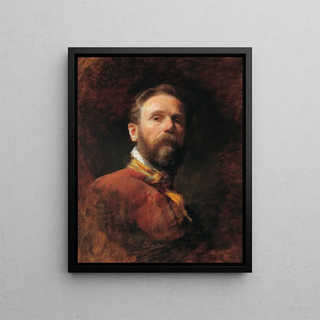Art print | Self-portrait (conflict of cases) - Friedrich von Amerling Source: Reproduction | Autoportrait (conflit de cas) - Friedrich von Amerling


View from behind

Frame (optional)
Friedrich von Amerling's "Self-Portrait (case conflict)" is a masterpiece that immerses viewers in the artist's intimacy while revealing the inherent tensions of his role as an image craftsman. This painting, distinguished by its boldness and psychological depth, invites reflection on identity and the artist's role in 19th-century society. Through this portrait, Amerling does not merely depict his face but also exposes the inner conflicts that traverse him, offering an introspective view of a time when art and the artist's personality began to merge.
Style and uniqueness of the work
Friedrich von Amerling's style is characterized by finesse and precision, reflecting undeniable technical mastery. In "Self-Portrait (case conflict)", the meticulous details of facial features, combined with a subtle color palette, create an atmosphere that is both melancholic and introspective. The carefully orchestrated light highlights the nuances of the skin and delicate shadows, emphasizing the complex expression of the artist. This painting stands out for its ability to capture not only Amerling's external appearance but also his state of mind. The slightly tilted posture and contemplative gaze testify to a deep, almost existential reflection, prompting viewers to consider the internal conflicts that may inhabit a creator.
The artist and his influence
Friedrich von Amerling, born in 1803 in Vienna, is one of the most representative artists of the Austrian Romantic movement. His work is often marked by a quest for authenticity and a desire to transcend the artistic conventions of his time. Amerling established himself as a renowned portraitist, capturing the essence of his contemporaries with rare sensitivity. His influence extends far beyond his era, inspiring many artists who, like him, seek to express profound emotions through the pictorial medium. "Self-Portrait (case conflict)" embodies this pursuit of authenticity, where the

Matte finish

View from behind

Frame (optional)
Friedrich von Amerling's "Self-Portrait (case conflict)" is a masterpiece that immerses viewers in the artist's intimacy while revealing the inherent tensions of his role as an image craftsman. This painting, distinguished by its boldness and psychological depth, invites reflection on identity and the artist's role in 19th-century society. Through this portrait, Amerling does not merely depict his face but also exposes the inner conflicts that traverse him, offering an introspective view of a time when art and the artist's personality began to merge.
Style and uniqueness of the work
Friedrich von Amerling's style is characterized by finesse and precision, reflecting undeniable technical mastery. In "Self-Portrait (case conflict)", the meticulous details of facial features, combined with a subtle color palette, create an atmosphere that is both melancholic and introspective. The carefully orchestrated light highlights the nuances of the skin and delicate shadows, emphasizing the complex expression of the artist. This painting stands out for its ability to capture not only Amerling's external appearance but also his state of mind. The slightly tilted posture and contemplative gaze testify to a deep, almost existential reflection, prompting viewers to consider the internal conflicts that may inhabit a creator.
The artist and his influence
Friedrich von Amerling, born in 1803 in Vienna, is one of the most representative artists of the Austrian Romantic movement. His work is often marked by a quest for authenticity and a desire to transcend the artistic conventions of his time. Amerling established himself as a renowned portraitist, capturing the essence of his contemporaries with rare sensitivity. His influence extends far beyond his era, inspiring many artists who, like him, seek to express profound emotions through the pictorial medium. "Self-Portrait (case conflict)" embodies this pursuit of authenticity, where the






